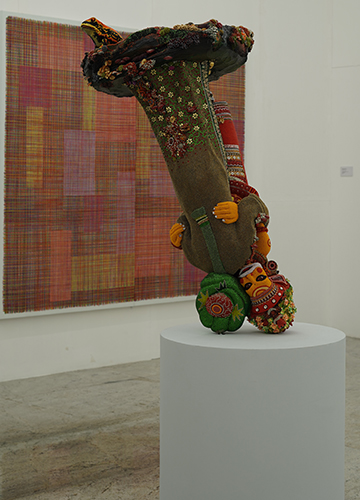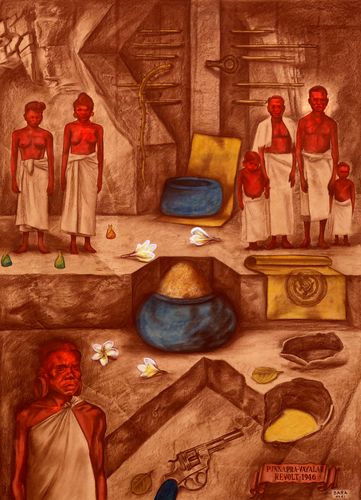Nine years ago photo artist K.R. Sunil saw a fascinating chavittunadakam performance by a group from Chellanam, a coastal village near Kochi, which stayed true to its original form in 16th century. A form of theatre which originated within the Latin Catholic community of Kerala, chavittunadakam resembles Europe’s opera, and features glittering costumes that resemble Greco-Roman style robes, intricate gestures, and rhythmic music. The stories are mostly heroic tales of Christian warrior kings of the Roman Empire.
The performance, involving fisherfolk and daily-wage workers, profoundly affected Sunil. So he became a frequent visitor to their village and homes. He recognised the stark contrast between their roles as royals and the harsh reality of living in extreme poverty, with their houses getting flooded frequently. Sunil observed that these men and women, who do the least damage to nature, unfortunately, bear the maximum brunt of climate change and environmental degradation. “So instead of their royal backdrops, I placed them in front of their own flooded houses,” said the photo artist. And that led to his photo series Chavittu Nadakam: Storytellers of the Seashore, which is currently being displayed at Contextual Cosmologies, an art exhWWibition in Thiruvananthapuram, showcasing works of 44 artists from Kerala.
Curated by Anushka Rajendran, Bose Krishnamachari, Premjish Achari and Sujith S.N., the show is being held at the College of Fine Arts in Thiruvananthapuram, which was established in 1881. Krishnamachari, the director of Kochi-Muziris Biennale, did the scenography, crafting, and designing for the show that features artworks of various mediums and sizes. Originally conceived as one of Krishnamachari’s four projects for Keraleeyam 2023―a festival being organised by the Kerala government to showcase the state’s achievements―the show will continue till December 31.
As I move through the exhibition space, I encounter myriad voices and visions. Mysuru-based artist Amjum Rizve, 33, presents a sculpture of a Sufi and a Muthappan Theyyam entwined in an inverted embrace. Cleverly concealed amidst this composition is a fungi-covered frog perched on the raised feet of the sculpture. Both Sufi and MuthappWan embody the realisation of divinity in humanity, and Rizve sculpted their inverted embrace using more than 1.5 lakh beads. Coming from an orthodox Muslim background, Islamic cultural practices formed the base of this young artist hailing from Kappad in Kozhikode. Rizve told me about his inspirations. “After my graduation, there was a gap of three years before I joined for my master’s. In that phase, where I had to strive for survival, I worked with my aunt, a tailor, and designed wedding dresses [with decorative elements],” he said.
“My master’s syllabus had a paper on Islamic art and other art forms,” said Rizve. “There, I was exposed to Persian carpets, Persian miniatures, and a lot of decorative images. The Persian miniaturists make their work in a meditative and disciplined process. I used to paint oil paintings arrogantly. But this work is a result of my transformation to be a more disciplined artist who takes time and makes the process of art a meditative process.” He opened his work for interpretations from the backdrop of the current political atmosphere in the country. There is clear yearning for fluid spaces instead of ghettos.
Elsewhere, a group of musicians from Germany were eagerly exploring the unique work of artist Vivek Vilasini. The work featured a re-enactment of the Last Supper―clearly inspired by Leonardo da Vinci’s version―starring 13 Kathakali performers tucking into appams and other traditional Kerala delicacies. Christine Evans, a band member hailing from Hamburg, was filled with awe. “We are great fans of any kind of high-quality art and we found such wonderful artworks here,” she said, “We felt like we just discovered a whole new colourful world and we are very grateful to be here.”
Krishnamachari said this artwork delves into the realms of conceptualism―an influential ism prevalent in art-making throughout the 20th and 21st centuries.
One of the first things that a person would notice when entering the exhibition space is a typography in Malayalam, Nammalenganenammalayi [How we become what we are] by Latheesh Lakshman, who calls himself an “artist + designer + illustrator + typography lover”. Later I saw some of his other quirky works with Malayalam words like Kashtapettishtapedenda [love a little less hard] and Engotta, Evidanna, Ara [to where, from where, who are you] with pigmented print plus serigraphy on museum paper as the medium. Krishnamachari calls Kashtapettishtapedenda an “iconic work” considering the contemporary design, graphics and art scene. “It is important to see how a typography gets transformed into a contemporary artwork,” said the veteran artist and curator. Lakshman, 43, who is working in the advertisement industry, is particular that his work communicates; he said he is fond of doodling and working on wordplays.
Uncovering muted voices from bygone eras, and confronting the narratives crafted under the guise of ‘established history’ is a realm that bold artists venture into. In Contextual Cosmologies, one encounters some notable works dealing with such historical narratives. For instance, Bara Bhaskaran’s Chamber of Amazing Museum, set against the backdrop of the violent Punnapra Vayalar revolt―a communist uprising in the princely state of Travancore leading to over a thousand deaths―examines the unheard voices of the martyrs’ widows, who played an equal role in the struggle yet remained unrecognised. “This work would certainly hold significance should a museum be established focusing on the Punnapra Vayalar revolt,” said Krishnamachari.
T.V. Santhosh’s History Lab series is also a work that deals with the idea of understanding history through different narratives, and various perspectives. At Contextual Cosmologies, one encounters the third instalment in the series―an installation of war-ravaged buildings with a countdown timer set for around 79 years, symbolising the average human life expectancy. This apocalyptic vision examines the future by reflecting on our turbulent past, drawn from history books and contemporary news imagery that shape people’s perspectives. In a world marked by news of conflicts, such artistic visions acquire heightened relevance.




